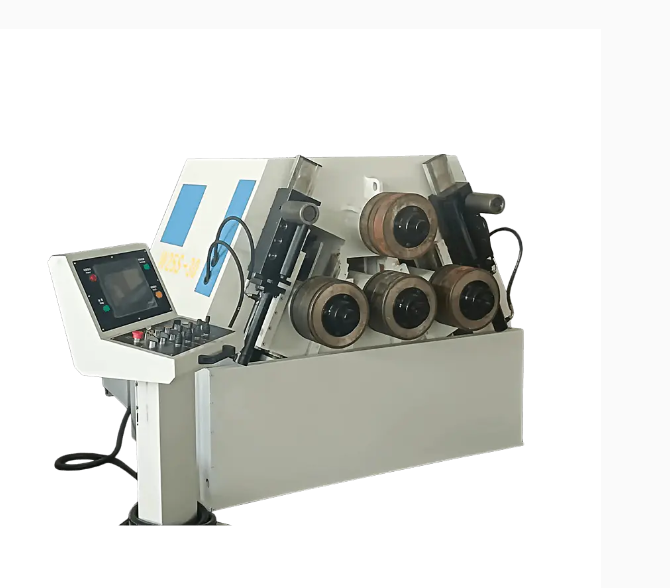Oct 11, 2025
Hydraulic Section Rolling Machine is a heavy-duty cold processing equipment that uses a hydraulic system as a power source and is specifically used to bend metal profiles (such as angle steel, channel steel, I-beam, flat steel, round tube, square tube, etc.) into arc or spiral shapes. When using a hydraulic section rolling machine, operators and maintenance personnel often encounter a series of problems. These problems can be mainly summarized into three categories: processing quality problems, hydraulic system failures, and mechanical and electrical failures.
Content
Cause: This is usually because the profile fails to maintain the correct angle with the roller axis (not parallel) during feeding. It may also be that the upper and lower rollers of the equipment itself are not parallel, or there is internal stress in the profile.
Solution: Ensure that the feeding direction is correct and carefully calibrate the reference surface of the profile. Regularly check and adjust the roller parallelism of the equipment.
Cause: The main reason is that the material rebound is not effectively compensated. The rebound effect of high-strength steel or aluminum alloy is particularly obvious. In addition, excessive pressure forming, premature unloading or insufficient rounding rolling can also cause this problem. Solution: It is necessary to use multiple progressive rolling, press down in small increments multiple times, and reserve rebound amount based on experience. During the rolling process, the template should be frequently used for calibration to ensure that the curvature is qualified.
Cause: Hard particles such as iron filings and welding slag adhere to the surface of the roller, which press into or scratch the surface of the workpiece under high pressure. The wear of the roller itself to produce pits or sharp edges is also a common cause. Solution: The roller and the working environment must be thoroughly cleaned before work. Check the surface finish of the roller regularly. If there is wear, it needs to be polished and repaired. If it is serious, the roller needs to be replaced.
Cause: The hydraulic pressure on both sides is unstable or inconsistent, resulting in uneven roller pressure. Uneven thickness or material of the profile itself can also cause such problems. Solution: Check whether the hydraulic system pressure is stable. Check the quality of the incoming materials to ensure that the profiles are uniform. Maintain a constant feed speed during operation.

Reason: The hydraulic oil level is too low; the hydraulic oil has not been changed for a long time, resulting in deterioration or incorrect viscosity; the oil pump is worn internally, resulting in reduced efficiency; the overflow valve is improperly adjusted or the valve core is stuck; the oil suction filter is clogged, resulting in poor oil supply.
Solution: First check and replenish the hydraulic oil. Check and clean or replace the filter. Check, clean or adjust the overflow valve. If the problem persists, the oil pump may need to be repaired or replaced.
Reason: The solenoid reversing valve core that controls the cylinder movement is stuck or the coil is burned; the internal seal of the cylinder is aged and damaged, resulting in internal leakage; the system pressure is insufficient; in a cold environment, the viscosity of the hydraulic oil is too high.
Solution: Check whether the solenoid valve is working properly, clean or replace the valve core/coil. Check the sealing of the cylinder and replace the seal. Ensure that the system pressure is normal. In cold weather, the equipment needs to be run at no load for preheating.
Cause: The oil pump is sucking air (the oil level is low or the suction pipe is leaking); air is mixed in the hydraulic oil; the oil pump bearings or internal components are damaged; the connection between the motor and the oil pump is misaligned.
Solution: Check and replenish the hydraulic oil, tighten the oil suction pipe joints to eliminate air leaks. Check the oil pump and couplings, and make corrections or replacements.
Cause: Cooling system failure (such as the cooling fan does not rotate or the water cooler is blocked); the overflow valve setting pressure is too high or it works in a high-pressure overflow state for a long time; the hydraulic oil brand is improperly selected or seriously contaminated.
Solution: Check and repair the cooling system. Readjust the overflow valve to a reasonable pressure. Replace the specified brand of clean hydraulic oil.
Cause: Loose joints; aging, wear or damage of sealing rings, O-rings and other seals; oil pipe burst. Solution: Tighten the joints; replace damaged seals and oil pipes.
(1) The roller does not rotate or makes unusual noises:
Cause: The transmission gear is broken or severely worn; the supporting bearing is lacking oil lubrication or is damaged; the reducer is faulty; the motor is faulty.
Solution: Check the condition of the gears and bearings, replace them in time and add grease regularly. Repair the reducer and motor.
Cause: The equipment anchor bolts are loose and the foundation is not solid; the roller is severely worn, resulting in dynamic imbalance.
Solution: Re-level and tighten the anchor bolts. Correct or replace the roller.
Cause: The buttons, limit switches and other components are damaged; the circuit is open or the fuse is blown; the PLC or relay module is faulty.
Solution: Have a professional electrician check the circuit and electrical components and replace the damaged parts.
Summary and Prevention
Most problems can be avoided through standardized operation and preventive maintenance:
Standardized Operation: Operate strictly according to instructions, avoid overloading, and utilize correct processing techniques.
Daily Inspection: Check the oil level, fasteners, and cleanliness before operation.
Regular Maintenance: Regularly replace hydraulic oil and filters, relubricate moving parts on schedule, and inspect the condition of key components.
Professional Training: Ensure operators and maintenance personnel are familiar with the equipment's performance and principles, enabling them to promptly identify and resolve simple faults. In the event of complex hydraulic or electrical faults, contact a qualified technician immediately for repair.